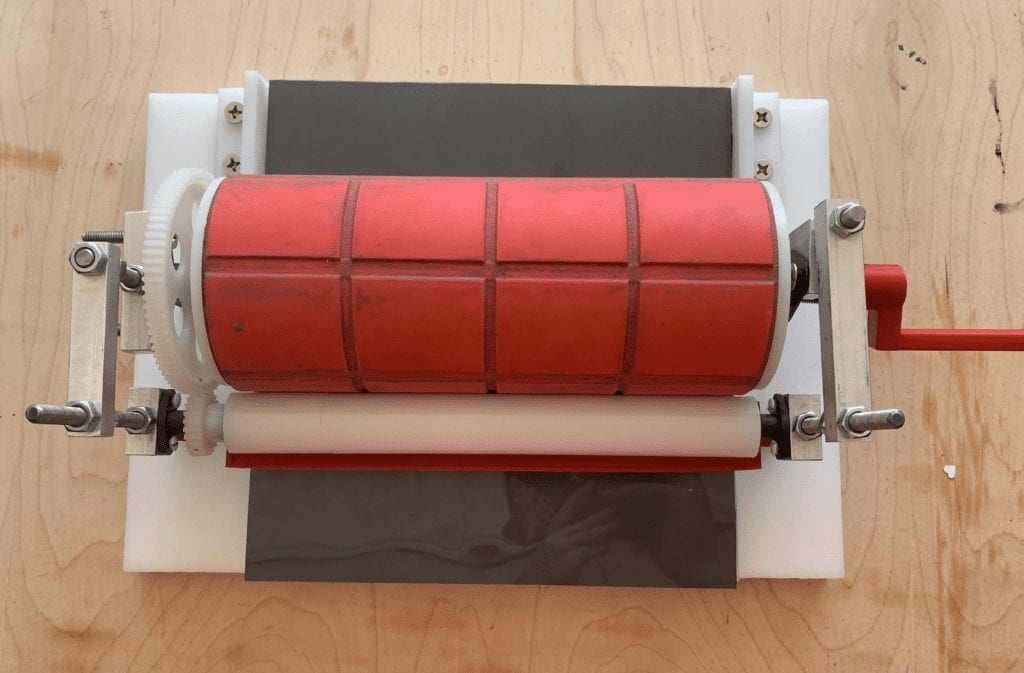Our Team
The Fever Dots team is comprised of four fourth year biomedical engineering undergraduates at Cal Poly.

Angela Cricelli
Design and Manufacturing Lead
I am a fourth year biomedical engineering undergraduate who will be beginning my Masters of Science in Biomedical Engineering at Cal Poly in Fall. I have interned in manufacturing and sustaining R&D in the medical device industry, and will be exploring a start-up environment this summer.

Rachel Kloth
Design and Manufacturing Lead
I am a fourth year Biomedical Engineering major and will be doing my Master’s at Cal Poly this coming Fall. I have done manufacturing internships in the prosthetic and orthotic industry and will be doing a manufacturing internship this summer with Dexcom to work with continuous glucose monitors.

Maetja Verbarendse
Substrate and Testing Lead
I am a fourth year Biomedical Engineering student starting the Regenerative Medicine Masters Program here at Cal Poly in the fall. With previous research and publication in medicinal chemistry, I look for future coursework in biologics and tissue engineering to enable a career in biotechnology.

Ruby Moreno
Ink and Testing Lead
I am a graduating biomedical engineering senior with a concentration in bioinstrumentation. I am from Sacramento, CA. I have a passion for helping others and the public health. This project gave me a way to contribute towards a device that is affordable and accessible for all. I am seeking a full-time career upon completing my classes this summer.
Acknowledgements
The Fever Dots Senior Project Team would like to send a huge thank you to our sponsors, Caroline and Margaret, Hannah Forbes and the Hannah Forbes grant, our advisor Dr. Whitt, and all of the students in the machine shops who advised in the manufacturing process.
Our Project's Videos
The following video showcases our device assembly close-up and discusses the functions of each part of the device.
Our Project's Digital Poster
Need Statement
- WellHouse Enterprises requires a semi-automated or automated manufacturing method to produce their novel product, a FeverDot. The manufacturing method must apply ink to the substrate, cut inked substrate into desired sticker shapes, and then package groups of stickers for sale. The goal is to design a robust process that is repeatable, reproducible, user-friendly, and has the ability to be up-scaled for mass production of FeverDots.
WEllHouse Enterprises current manufacturing Process
The current process to manufacture a FeverDot is completely manual. Ink is hand-painted onto an entire sheet of substrate, the shapes are then individually cut out, and then a group of stickers is gathered together for one package. The general workflow of their current manual manufacturing process is seen below.
Indications for Use
FeverDots is indicated for use by the general population to detect surface temperature. The product can be applied directly to clean dry surfaces and indicate surface temperature within seconds. The proprietary ink changes colors at the designated temperature. This product can be used to supplement fever identification. If the dot goes pink, then a thermometer should be used to confirm fever. This product is intended for use on the temple for best results. After two days the sticker can be removed and discarded. This product is safe for users with no allergies to adhesive sticker material.
Specifications
Requirement | Measurement | Specification |
Maintain ink integrity | Visual | Black to Pink |
Ink is stamped | Count | 100% |
Blocks are evenly spaced | Inches | 0.15 |
Shape is defined | Count | 100% |
Individual Shapes are appropriately sized | Inches | 0.275 |
Printing press can fit a full sheet of substrate | Inches | 8.5”x11” |
Sticker Design
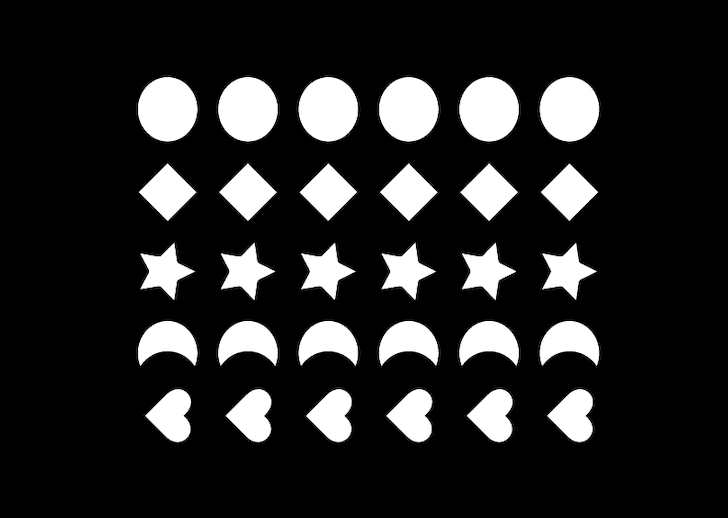

This project is sponsored by WellHouse Enterprises
Prototyping
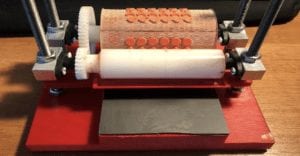
A 3″ Prototype was built during the design process for testing and development. The prototype has a 3D printed base and ink tray, with machined cylinders and bearing attachments.
Design Considerations
Prototypes were developed that were based on the design of a rotary webfed printing press. An inking cylinder (shown in white) rolls through an ink tray and picks up ink that is transferred to the stamping cylinder, that has a rubber sheet (orange) with the pattern of the shapes to be printed. When rotating the cylinders, connected by gears, and feeding paper through, the design is printed onto the paper.
The concept for supporting the cylinders was to use threaded rods with nuts that can control the heights of all components. This is essential because the heights of the cylinders determine the amount of ink transferred and the pressure that the ink is stamped at. With the threaded rod design, the heights of the press can be modified depending on the ink used (which may have varying viscosities) and substrate used (which may have varying thickness). A handle can apply a moment to one of the cylinders, and with the gears interacting both cylinders rotate. The ink tray serves as an ink reservoir that is elevated to height directly under the ink collection cylinder. The depth of the tray can be modified to increase or decrease the amount of ink held such that one full tray of ink may produce varying amounts of stickers depending on the lot requirements.
CAD

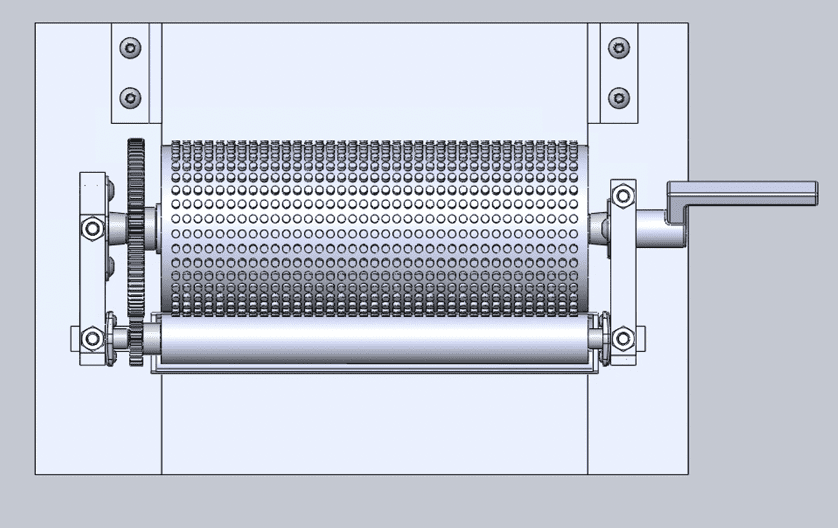
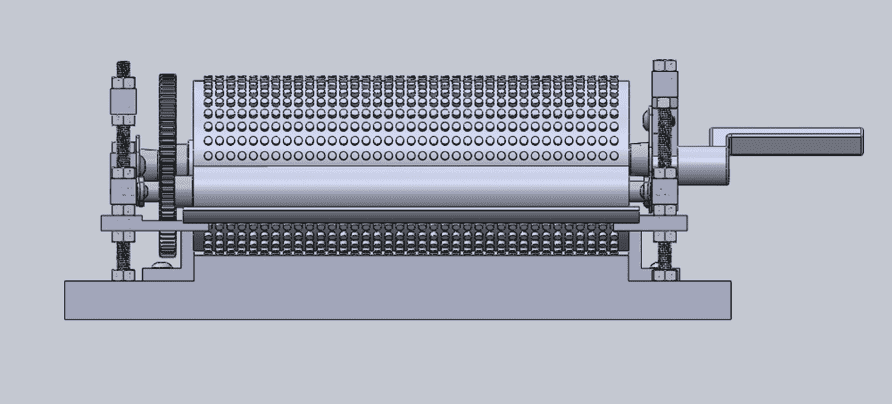
Testing
In order to meet customer requirements and specifications, two sets of tests were performed. Variations of factorial designs assessed variability in stamp height, substrate material, feed direction and ink composition. All testing was completed on the 3″ prototype press.
Success Criteria
- Shapes are stamped
- Each block has clear definition and even spacing
- Shapes have a full, opaque coverage of ink
- Sheet does not get jammed between cylinders
- Color changes from black to pink

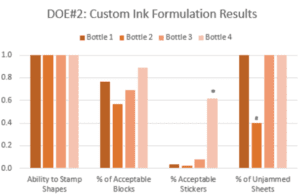
Analysis
The first test investigated varying material substrate, height of stamp contact and feed direction over a course of four experiments (n=5). The fractional factorial design found matte substrate and low heights were most favorable for printing with flexographic ink. Feed direction data was inconclusive.
The second set tested pigment concentrations and viscosities for four different formulations (n=5). Quantity of binder, feed direction, substrate type and stamp height were held constant throughout testing. The full factorial design concluded higher viscosity is most favorable for the transfer of ink. Both sets of tests are based off the criteria that shapes are stamped, block definition, ink is opaque, no jamming occurs and color changes.
Full Sized Design

The full sized design allows for printing stickers on an 8.5″x11″ sheet of substrate with one full rotation of the stamping cylinder. The rubber pattern has been lasered into a block design to solve alignment issues between the pre-cut substrate and the patterned rubber. The blocks paint an entire section of stickers, which still saves ink as compared to painting the entire sheet. The press works by priming the cylinders with two full rotations while feeding scrap paper through the press. Then, aligning the paper to the marked lines per the operators manual, the user can print sheets of Fever Dots by rotating the handle and feeding paper through. After proper dry time, the inked stickers can be packaged for sale.

